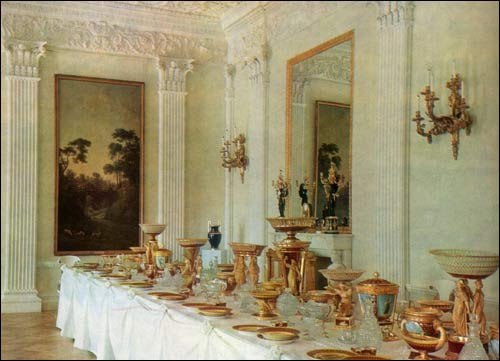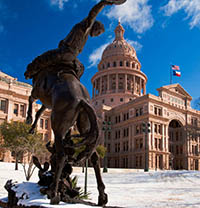Pallasweb.com Blog - Find the latest industry news, tips and tricks at Pallasart Web Design

|


The Dining Room, which is the largest of the ground-floor rooms, was designed by Cameron; the work of decoration started by him was finished by Brenna. The rhythmic pattern of white fluted pilasters with Corinthian capitals on a pale pistachio green background of the walls gives the hall a dignified air. The walls are surmounted by a moulded frieze with acanthus scrolls, classical vases, cupids, lions, etc.
The large oval bay-leaf garland in the centre of the ceiling was intended as a frame for a panel which, however, was never painted. In reconstructing the hall, Voronikhin very tactfully added to Cameron's ceiling decoration a finely designed moulded border harmonizing with the frieze. The lush acanthus that Voronikhin was so fond of, agrees perfectly with Cameron's architectural idiom - an antique ornament in low relief on a delicately coloured background. The plate-glass French windows of the Dining Room open upon a broad granite stairway leading down to the park. This creates a sense of unity with nature, which is further sustained by landscape panels on the Dining Room walls, depicting park scenery with the waterfall on the Slavianka, the Ruin Cascade in Old Sylvia, the Temple to Friendship and the Peel Tower, painted by the Russian artist Andrey Martynov in 1800. Many objects in porcelain decorating the interiors record the early period of Pavlovsk, as for example articles made at the St Petersburg Imperial Porcelain Factory and painted after the drawings by Andrey Martynov and his teacher Semion Shchedrin. The medallions on the two companion vases created about 1763, now exhibited in the Dining Room, show the town's first buildings, Paullust and Marienthal, some of the park pavilions and even Cameron's palace in the process of building, with minute figures of workmen on the scaffolding. Another art treasure exhibited in the Dining Room is the so-called Guryev dinner service of porcelain, with sculptural decorations executed from the models of Stepan Pimenov. It was made between 1807 and 1817 at the St Petersburg Imperial Porcelain Factory. The Guryev service is remarkable for the subject matter of its painted and sculptural decorations. A work of court art, it evinces a hitherto most unusual interest in the life of the common people. This has an explanation in the history of the country. The War of 1812 against Napoleon, whose armies had invaded Russia, caused a tremendous growth of patriotic feeling among all strata of Russian society. The tall dessert vases of the Guryev service, intended to occupy a prominent position along the central line of the table, are decorated with sculptural figures of peasant girls in Russian national costume. Motifs of Russian country dances are painted on the ice pails, and figures in national costume representing the various peoples of the Russian empire, on the plates. The wine-coolers are embellished with views of Moscow and St Petersburg and their environs, done after the canvases and drawings of such landscape painters as Semion Shchedrin or Fiodor Alexeyev. The deep, rich russet ground tone in combination with gold gives the service an air of splendour and dignity.    |

|





